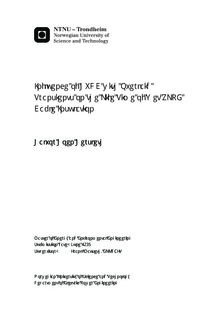| dc.description.abstract | There are many technological challenges related to the production of electrical power from offshore wind farms. Norwegian companies are working on different aspects of offshore wind power generation and the Norwegian Research Council has in this context supported a five year project called: ?High Voltage AC and DC Subsea Cables for Offshore Wind Farms and Transmission Grids?. This master thesis has been a part of that project. Power electronics used for HVDC converters will stress the cable with a HVDC component with overlaid transients. The effect of the DC component and the overlaid transients on the performance of the polymeric cable insulation is not yet known and the main purpose of this master thesis has been to investigate how transients can influence water tree growth within wet XLPE insulation. The effect of the DC component has also been evaluated. Laboratory experiments were conducted on Rogowski shaped test objects with an insulation thickness of 1.1 mm. 20 sodium chloride particles were added on the lower semiconductor during the manufacturing process. This was done to facilitate the initiation of water trees. The finished test objects were preconditioned with demineralized water in a heating cabinet at 30 °C for four weeks to ensure that the insulation was saturated with water. An experimental setup capable of applying a DC voltage with a superimposed high frequency AC component was used to simulate the HVDC component and the overlaid transients that occur close to the power electronics used for AC to DC conversion. Two sets of experiments were conducted. The first set was conducted using a 15 kHz AC component, with resulting electrical field strength of ± 2.05 kV/mm. The second set of experiments was conducted combining the same high frequency AC component with a superimposed DC voltage, resulting in an electrical field strength of 12 ± 2.05 kV/mm. Nine Rogowski shaped test objects were aged in both sets of experiments. Three test objects were aged for one week, another three for two weeks, while the last three test objects were aged for three complete weeks. The test objects were kept in a heating cabinet at 30 °C during testing, and with the exception of the electrical field, treated identically during both sets of experiments. All test objects experienced water tree initiation and growth. The length of the longest water tree and the aggregated water tree density were observed to increase as a function of ageing time for both sets of experiments. All water trees were oblong and grew in the direction of the electrical field. The longest observed water tree, after three weeks of ageing exposed to an AC component only, was 607 µm, corresponding to 55 % of the total insulation thickness. Two out of three test objects, exposed to a DC voltage with a superimposed AC component, suffered breakdown before enduring three complete weeks of ageing. This was most likely the result of a water tree bridging the 1100 µm thick insulation. Test objects exposed to a DC voltage with a superimposed high frequency AC component were also observed to experience a higher aggregated water tree density, with vented water trees observed at the lower semiconductor constituting the main difference. As a result, it could be argued that the DC voltage, when combined with a superimposed high frequency AC component, increases water tree initiation and growth within wet XLPE insulation. The experiments also indicate that HVDC cables should be made water tight to prevent water tree degradation due to the transients originating from the switching of the power electronic converters. | nb_NO |

